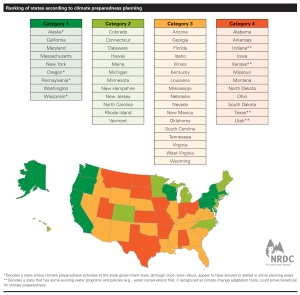The Natural Resources Defense Council has released a report on how well states are preparing to meet the challenges of how climate change will affect their water resources.
Ready or Not: How Water-Ready is Your State?
So how ready is Montana? Unfortunately, we rank in the bottom of the class. Montana is among the dozen states that “are not acting and remain woefully unprepared.” Not really much of a surprise I guess, given the bad rap any kind of “planning” has taken in the Treasure State, but pretty sad none the less. According to NRDC;
Water Readiness Map
To date, Montana has not made much progress with regard to planning for water resources in general, let alone planning for likely climate change impacts such as increased drought and flooding.
They predict “The state could suffer nearly $80 million in crop losses annually by 2050 as a result of climate change,1 and the disappearance of glaciers in Glacier National Park and the reduction in suitable habitat for coldwater fisheries could impact the number of visitors—some 10 million annually—who come to the state and contribute billions to the state economy.”
Since the 1950s, Montana has seen an average temperature rise of 3 degrees C and we could see a 5-degree rise by the turn of the century.
The rate of warming during the winter and spring has significantly exceeded the warming in the summer. Precipitation patterns also have changed, with the Northern Rockies experiencing less winter snow and the southeastern plains receiving more spring and fall rain. In addition, eastern Montana has experienced a 10 percent decrease in annual precipitation over the past 100 years. Across the west, peak spring runoff occurred 10 to 30 days earlier in the 1948‒2000 period than it did prior to that time. However, the most notable impact of climate change has been the disappearance of alpine glaciers as a result of accelerated melting during the spring and summer season. Of the 37 named glaciers in Glacier National Park, only 25 remain, with 11 of the 12 glaciers lost having disappeared since 1986.
But why plan for the obvious? This is only the greatest threat our state will face for the next century or so. We like living on the edge.
(cross-posted with Flathead Valley Trout Unlimited)
Filed under: Button Valley News, Climate Change, Montana Environment, Montana News, Montana People, Montana Politics, Water, Wildlife and Environment |







Leave a comment